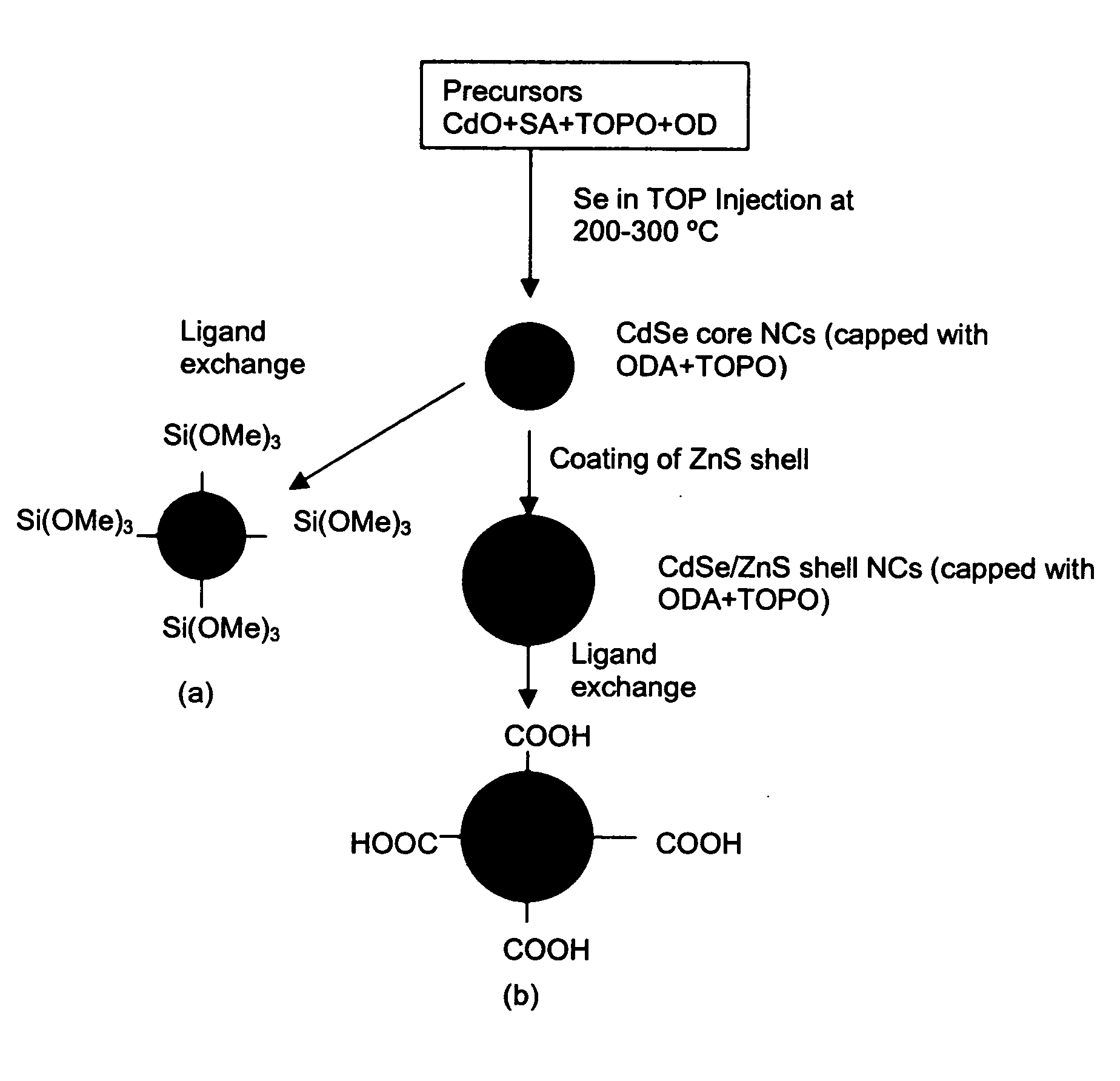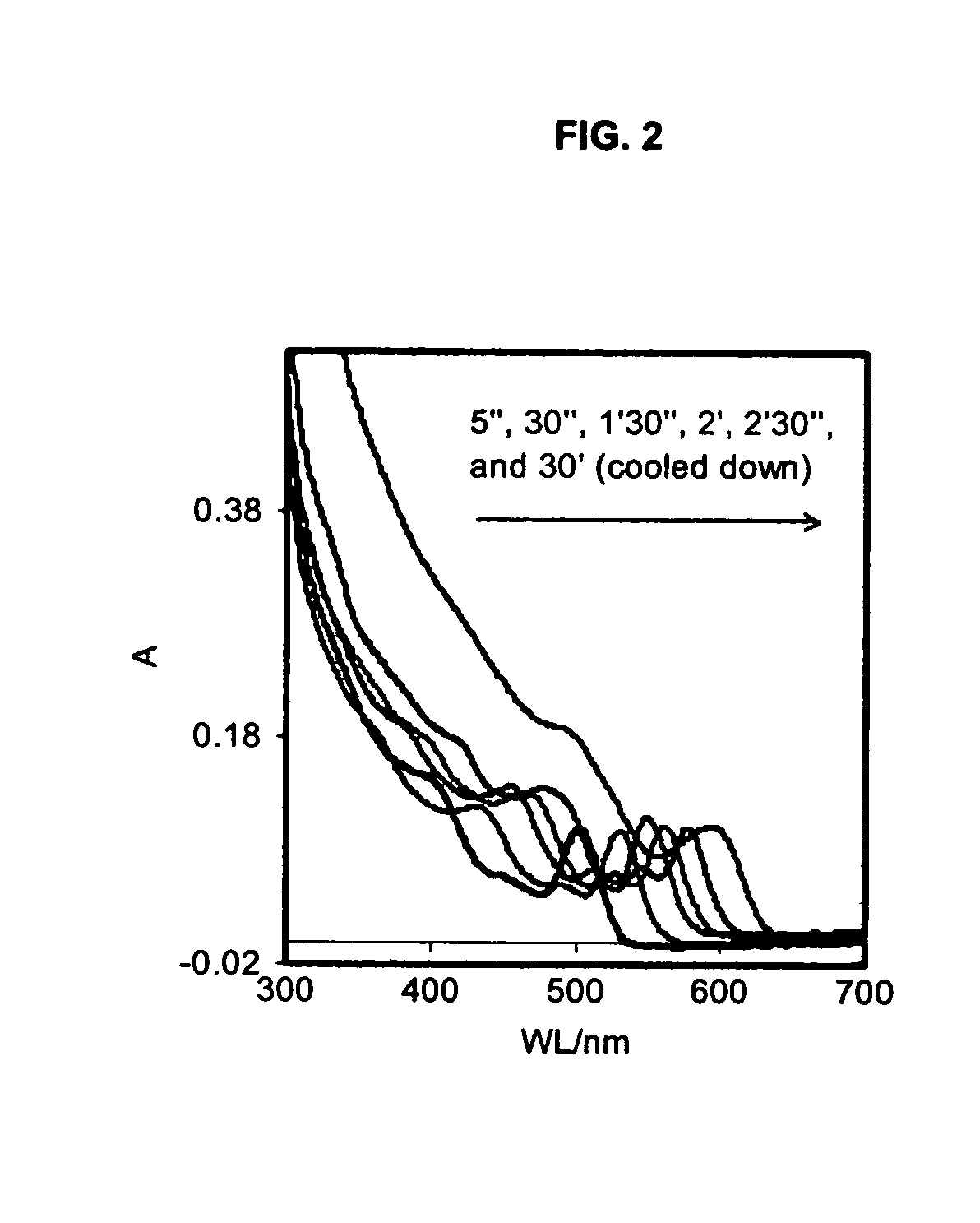Nanocrystal coated surfaces
a nanocrystal and surface technology, applied in coatings, instruments, transportation and packaging, etc., can solve the problems of inconsistent results of previous attempts to prepare nanocrystal standards, and achieve the effects of strong fluorescence, stable against photo-oxidation and aging, and good monodispersity
- Summary
- Abstract
- Description
- Claims
- Application Information
AI Technical Summary
Benefits of technology
Problems solved by technology
Method used
Image
Examples
example 1
Preparation of CdSe Core Nanocrystals
[0099] Materials. Precursors cadmium oxide (CdO), cadmium acetate, stearic acid, trioctylphosphine oxide (TOPO), octadecylamine (ODA), selenium, trioctylphosphine (TOP), (N-(2-aminoethyl)-11-aminoundecyltrimethoxysilane (AEAUTMS), dimethyl Zinc, hexamethyldisilathiane ((TMS)2S), mercapto-succinic acid (MSA), ethylene glycol, and tetraethyl orthosilicate (TEOS), etc, were purchased from Adrich and used as received. Chloroform, methanol and other reagents are in analytical grade. Epoxide-terminated glass slides were purchased from Quantifoil, Inc.
[0100] Synthesis of CdSe NCs. A selenium stock solution was prepared under an argon atmosphere. The solution was made by mixing 0.08 g of selenium, 2.00 g of trioctylphosphine (TOP), and 0.035 g of anhydrous toluene (99.8%) in a glass vial and sealed with a rubber septum.
[0101] 4.00 g of TOPO and 0.05 g of cadmium acetate were mixed in a 50 ml 3-necked flask. The mixture was heated to 330° C. under argo...
example 2
Preparation of CdSe / ZnS Core / Shell Semiconductors
[0102] In a typical synthesis, 0.024 g of CdO and 0.4 g of Stearic acid were loaded into a 50 ml three-necked flask and heated to 200° C. under Ar protection until it becomes colorless. The mixture was then cooled down to room temperature. 3.0 g TOPO and 3.0 g ODA were added to the flask and heated to 300° C. Then a solution of 0.2 g Se in 4 g TOP is injected into the reaction flask rapidly. The temperature was adjusted to 200° C. at which time ZnS precursors 0.40 ml dimethylzinc and 0.07 ml (TMS)2S in 2 ml TOP were injected slowly into the reaction flask over 5 to 10 min. The reaction mixture was then kept at 100° C. for 3 hrs. The solid NCs can be obtained by precipitating the NCs with addition of methanol. This powder was used to prepare water-soluble NCs.
example 3
Depositing of Arrays
[0103] Hydrophilic CdSe NCs were prepared by exchanging of TOPO and ODA molecules by AEAUTMS. Ethanol solution of the water-soluble NCs was used for printing of the NC arrays on glass surface.
[0104] Water-soluble NCs were prepared by heating mixture of the core / shell NCs with carboxylic acid-terminated thiols in methanol at 50° C. to 70° C. under protection of Ar. Aqueous solution of the core / shell NCs was used for fabrication of the NC arrays on glass surface.
[0105] The NC solutions were deposited on the surface using a standard micro-array printer.
PUM
| Property | Measurement | Unit |
|---|---|---|
| diameter | aaaaa | aaaaa |
| diameter | aaaaa | aaaaa |
| diameter | aaaaa | aaaaa |
Abstract
Description
Claims
Application Information
 Login to View More
Login to View More - R&D
- Intellectual Property
- Life Sciences
- Materials
- Tech Scout
- Unparalleled Data Quality
- Higher Quality Content
- 60% Fewer Hallucinations
Browse by: Latest US Patents, China's latest patents, Technical Efficacy Thesaurus, Application Domain, Technology Topic, Popular Technical Reports.
© 2025 PatSnap. All rights reserved.Legal|Privacy policy|Modern Slavery Act Transparency Statement|Sitemap|About US| Contact US: help@patsnap.com



